You’d have to have your head in the dirt to miss all the garden books in every bookstore and garden center, not to mention on the Internet. It’s clearly Spring and growing season!
But these are not your garden-variety garden books! This selection of seven books from the GoodFood World library has not been chosen to tell you how to design, construct, and grow your garden. They are to inspire your thinking, to get those creative juices flowing.
This mixed (book) bag of reading material offers the spirit of the garden from authors as varied as Japanese, Native American, and French. We’ve even included a book about a 17th century garden that is still producing in England.
Pull up a chair, grab a book and prepare to be amazed.
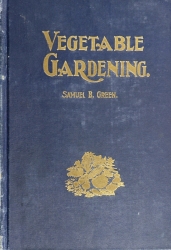
Vegetable Gardening – A Manual on the Growing of Vegetables for Home Use and Marketing, Samuel B Green (Webb Publishing, 1914)
From the preface:
This book was prepared primarily for the School of Agriculture of the University of Minnesota, where it has been used as a text book since it was first published.
It is the result of the development of the system of teaching at this school and is intended for students of the high school grade.
Topics include manures, tillage, seed sowing and growing, marketing, and a calendar of garden operations. (Available in original hardcover here, and as a reproduction here.)
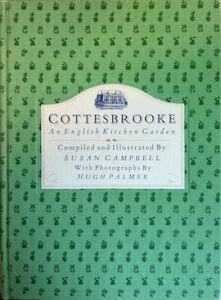 Cottesbrooke: An English Kitchen Garden, Susan Campbell (Salem House, 1987)
Cottesbrooke: An English Kitchen Garden, Susan Campbell (Salem House, 1987)
Cottesbrooke’s kitchen garden dates from about 1628, and has been in constant cultivation since. An English Kitchen Garden describes two acres of vegetables, an extensive orchard, glasshouses (including peach and carnation houses) and even such wonderful things as the vegetable washing room and the mushroom house.
Gardens like this were the rule, rather than the exception, in all “proper country establishments” before World War II.
Enjoy a full year of Cottesbrooke in this book and – even though it describes a very large and very diverse garden – you don’t need much space to experiment a little in your own plot or pot. (Available new or used here.)
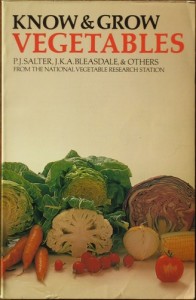 Know & Grow Vegetables, P.J. Salter, J.K.A. Bleasdale (Oxford University Press, 1979)
Know & Grow Vegetables, P.J. Salter, J.K.A. Bleasdale (Oxford University Press, 1979)
Gardening is usually considered to be an art but in fact “green fingers” are not required for producing good vegetable crops.
The simple instructions and practical advice given in this book are based on modern scientific research and will work in your garden, because the essential feature of science is that it must be repeatable.
The book deals with spacing sowing (including the novel method of fluid sowing) and planting, feeding, and watering different vegetable crops, and also how the vegetables can be protected from pests and diseases. (Available used here.)
Eco-Agriculture: Food First Farming, Theory and Practice, Marthe Kiley-Worthington (Souvenir Press, 1993)
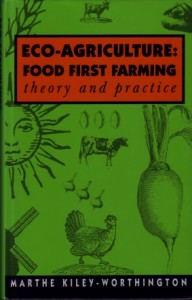 Modern high-tech farming is responsible for many of the problems that face the world today. In the developed countries it has caused soil depletion, massive pollution, loss of wildlife and a range of maladies in domestic animals kept in concentration-camp conditions. It is also inefficient, demanding high input and resulting in overproduction and waste on a criminal scale.
Modern high-tech farming is responsible for many of the problems that face the world today. In the developed countries it has caused soil depletion, massive pollution, loss of wildlife and a range of maladies in domestic animals kept in concentration-camp conditions. It is also inefficient, demanding high input and resulting in overproduction and waste on a criminal scale.
In the countries of the Third World, it has destroyed traditional, successful farming methods and the communities that go with them, has failed to work because it does not adapt to local conditions, and has lead to widespread starvation.
Marthe Kiley-Worthington maintains that the solution lies in eco-agriculture, a self-sustaining, ecologically and ethically sensitive system that puts food first, adapts to any type of soil or climate, and allows humans and animals to live together in harmony with nature. (Available new or used here.)
The One-Straw Revolution, Masanobu Fukuoka (Other India Press, 2006)
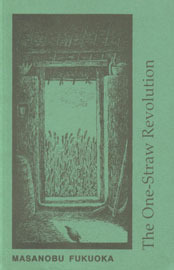 Call it “Zen and the Art of Farming” or a “Little Green Book,” Masanobu Fukuoka’s manifesto about farming, eating, and the limits of human knowledge presents a radical challenge to the global systems we rely on for our food. At the same time, it is a spiritual memoir of a man whose innovative system of cultivating the earth reflects a deep faith in the wholeness and balance of the natural world. As Wendell Berry writes in his preface, the book “is valuable to us because it is at once practical and philosophical. It is an inspiring, necessary book about agriculture because it is not just about agriculture.”
Call it “Zen and the Art of Farming” or a “Little Green Book,” Masanobu Fukuoka’s manifesto about farming, eating, and the limits of human knowledge presents a radical challenge to the global systems we rely on for our food. At the same time, it is a spiritual memoir of a man whose innovative system of cultivating the earth reflects a deep faith in the wholeness and balance of the natural world. As Wendell Berry writes in his preface, the book “is valuable to us because it is at once practical and philosophical. It is an inspiring, necessary book about agriculture because it is not just about agriculture.”
Trained as a scientist, Fukuoka rejected both modern agribusiness and centuries of agricultural practice, deciding instead that the best forms of cultivation mirror nature’s own laws. Over the next three decades he perfected his so-called “do-nothing” technique: commonsense, sustainable practices that all but eliminate the use of pesticides, fertilizer, tillage, and perhaps most significantly, wasteful effort.
(Description from IndieBound.org. Book available here.)
Buffalo Bird Woman’s Garden, Gilbert L. Wilson (Minnesota Historical Society Press, © 1917, Reproduction 1987)
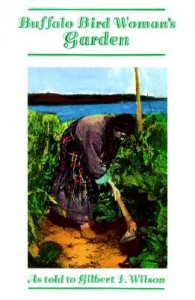 Buffalo Bird Woman (Maxidiwiac Waheenee) (1839-1932) was a Hidatsa who experienced the traditional life of her people in what is now the Fort Berthold Reservation in North Dakota. She learned and practiced all the traditional Hidatsa skills such as gardening, the preparation of food, weaving and many others.
Buffalo Bird Woman (Maxidiwiac Waheenee) (1839-1932) was a Hidatsa who experienced the traditional life of her people in what is now the Fort Berthold Reservation in North Dakota. She learned and practiced all the traditional Hidatsa skills such as gardening, the preparation of food, weaving and many others.
Buffalo Bird Woman held to the traditional ways of her culture and generously shared them through her stories and teachings. Through oral tradition she described her own experience and the lives and work of women in Hidatsa culture. Her works include: Agriculture of the Hidatsa Indians: An Indian Interpretation (1917) and Waheenee: An Indian Girls Story (1921). (Description from IndieBound.org. Book available here.)
Intensive Culture of Vegetables: French System, A. Aquatias (Solar Survival Press, © 1913, Reproduction 1978)
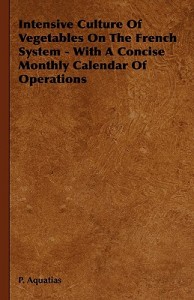 “Crops succeed one another every six weeks and after each the cultivator finds his soil as productive and as workable as before. Because he is devoted to it, he esteems it as no one ever esteemed it before, and as no gallant has ever esteemed his lady love.”
“Crops succeed one another every six weeks and after each the cultivator finds his soil as productive and as workable as before. Because he is devoted to it, he esteems it as no one ever esteemed it before, and as no gallant has ever esteemed his lady love.”
Once the meaning of this quotation is fully understood, it will give a fair idea of the spirit that should dominate the enthusiast in the intensive culture of vegetables. The cultivator must be devoted to and interested in his work and really love the land, the mother of all wealth and production and the most important asset at his disposal.
The aim of this system is not so much what a crop will bring or what profit is to be derived, as to obtain from the land all that God wanted us to get from it for our welfare, livelihood, and happiness. In this mercenary age, the love of gain dominates all our actions. We are always calculating on the highest returns for the least exertion, and we are often led to believe that practice of a method is accompanied by big profit.
Fortunately we find our mistake at an early date, and as the corollary of this love of gain has forced us to specialize in a particular branch of production if we desire to compete successfully. We all have a natural tendency towards gardening that manifests itself from the earliest age, but it can only be adopted as a profession when we have trained ourselves in one of its numerous branches.
The intensive culture of vegetables, to be successful, must be treated as a specialty it is such a complex system of cost, labor, and brain that to understand it thoroughly it must be judged in its entirety.
Everything is weighed, calculated, timed, and checked every crop has a cycle of growth to follow and it must work as a piece of ingenious mechanism for the welfare of the others that succeed it. (Description from IndieBound.org. 2007 hardcopy of the book available here.)
